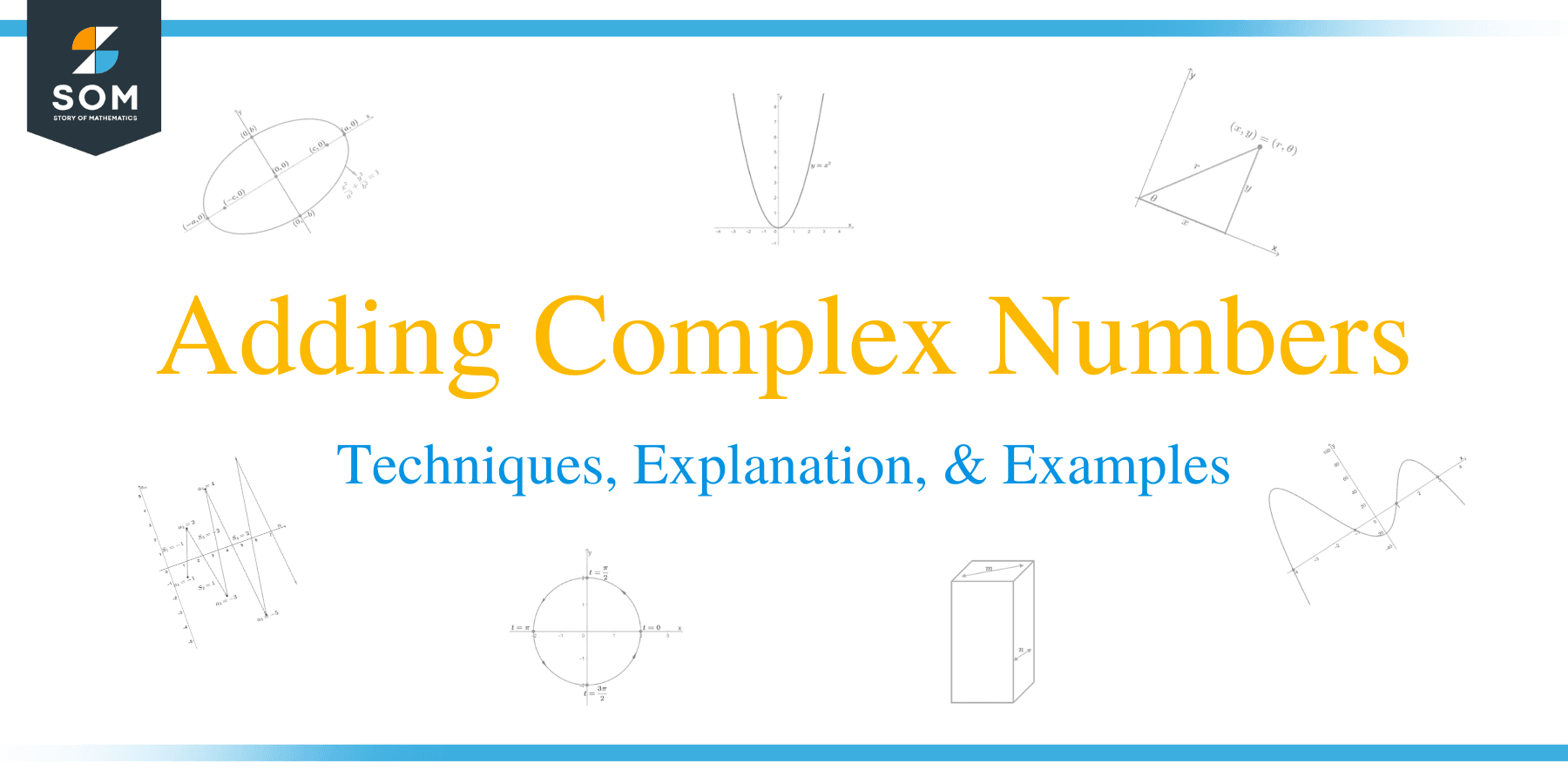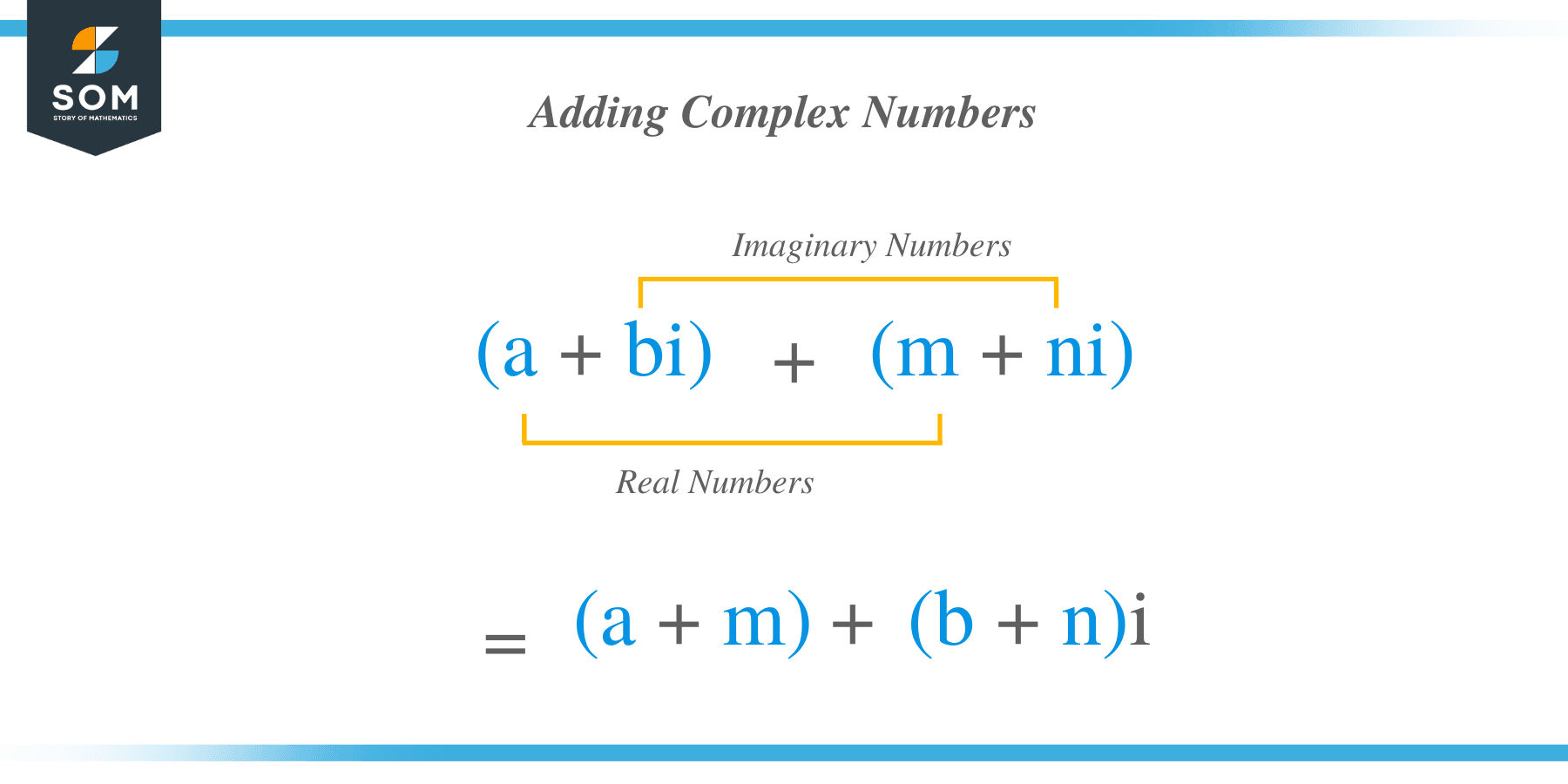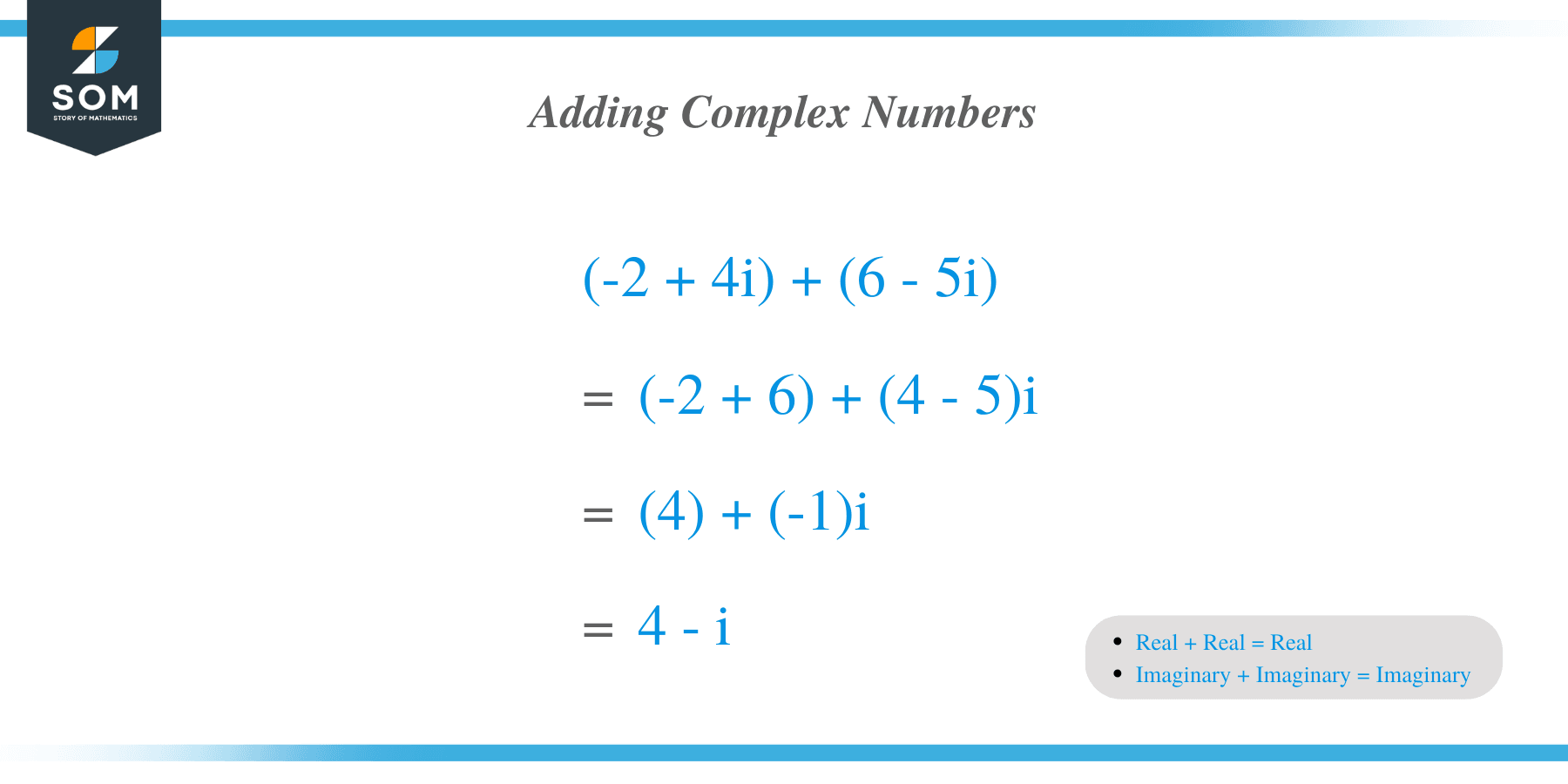JUMP TO TOPIC
Adding Complex Numbers – Techniques, Explanation, and Examples
 When studying complex numbers, it is important for us to also learn how we can combine and add two complex numbers. The process of adding complex numbers is actually not new to us, so it’s a reintroduction of what we’ve already known in the past.
When studying complex numbers, it is important for us to also learn how we can combine and add two complex numbers. The process of adding complex numbers is actually not new to us, so it’s a reintroduction of what we’ve already known in the past.
When adding complex numbers, we group the real number parts and the imaginary parts together.
Adding complex numbers is like adding two binomials together. By the end of this article, you’ll understand why this is so. We’ll also apply the different properties of addition in the context of complex numbers.
Let’s go ahead and start by reviewing what makes up complex numbers first.
How to add complex numbers?
Recall that the general form of a complex number is $a + bi$, where $a$ is the real number part and $bi$ is the imaginary number part.
When adding two complex numbers, we treat each part as independent variables. This means that we can only add “like terms”, where terms represent the real numbers and imaginary numbers.
Given $a + bi$ and $m + ni$, its sum can be determined by adding $a$ and $b$ as well as the imaginary parts, $bi$ and $ni$.
$\begin{aligned}(a + bi) + (m + ni) &= (a + b) + (m +n)i \end{aligned}$
This is the general form to guide us when adding two complex numbers.
This means that if we want to add $4 – 2i$ and $9 + 7i$, we group the terms as shown below.
$\begin{aligned} ({\color{blue}4 }- {\color{green}2i }) + ({\color{blue}9 } + {\color{green}7i }) &= ({\color{blue}4 } + {\color{blue}9 }) + ({\color{green}-2 + 7})i\end{aligned}$
Simplifying the two groups will lead us to the simplified sum of the two complex numbers.
$\begin{aligned} ({\color{blue}4 } + {\color{blue}9 }) + ({\color{green}-2 + 7})i &= 13 + 5i\end{aligned}$
We can use the same principle when adding other complex numbers. It’s also helpful to know that the addition properties we use for real numbers will still apply to complex numbers.
Complex number addition property
Let’s observe how the addition properties apply to complex numbers. Again, we use $a + bi$ and $m + ni$ to represent two complex numbers.
Commutive Property
When the order of two complex numbers is interchanged, the sum will remain the same.
Let’s go ahead and verify this using two general forms of complex numbers.
$\begin{aligned} (a + bi) + (m + ni) &= (a + m) + (b + n)i\\(m + ni) + (a + bi) &= (m + a) + (n + b)i\\&=(a +m) + (b + n)i\\\\(a +bi) + (m+ ni) &= (m + ni) + (a + bi)\end{aligned}$
From this, we can see that $(a +bi) + (m+ ni)$ will always be equal to $(m+ ni) + (a +bi)$.
Associative Property
Let’s say we have a third complex number, $p + qi$, then if we add the first two complex numbers followed by the third complex number, the result will be the same if we add the last two complex numbers first.
$ [(a + bi) + (m + ni)] + (p + qi) = (a + bi) + [(m + ni) + (p + qi)]$
$\begin{aligned} (a + bi) + (m + ni) &= (a + m) + (b + n)i\\(m + ni) + (a + bi) &= (m + a) + (n + b)i\\&=(a +m) + (b + n)i\\\\(a +bi) + (m+ ni) &= (m + ni) + (a + bi)\end{aligned}$
From this, we can see that $(a +bi) + (m+ ni)$ will always be equal to $(m+ ni) + (a +bi)$.
$\begin{aligned} [(a + bi) + (m + ni)] + (p + qi) &= [(a + m) + (b + ni)] + (p + qi)\\&= (a + m + p) + (b + n + q)i\\(a + bi) + [(m + ni) + (p + qi)] &= (a + bi) + [(m + p) + (n + q)i ]\\&= (a + m + p) + (b + n + q)i\\\\ [(a + bi) + (m + ni)] + (p + qi) &= (a + bi) +[ ( m + ni) + (p + qi)]\end{aligned}$
We’ve just verified the associative property as shown above. This means that associative property will indeed apply to all complex numbers.
Zero Property
When a complex number is added to zero, the result will still be the given complex number. Meaning, $(a + bi) + 0 = a + bi$.
This property is a bit intuitive, but we can still go ahead and verify this to also practice adding complex numbers.
$ \begin{aligned} (a + bi) + 0 &= (a + bi) + (0 + 0i)\\&= (a + 0) + (b + 0)i\\&= a + bi\end{aligned}$
We’ve just explored everything that we need to learn when it comes to the addition of complex numbers. Let’s go ahead and try out some problems to check our knowledge.
Example 1
Which of the following returns the correct value for $(-2 + 4i) + (6 – 5i)$?
a. $-8 – 9i$
b. $4 – i$
c. $4 – 9i$
d. $8 – i$
Solution
To add two complex numbers, we simply add the real number parts and the imaginary number parts.
$ \begin{aligned} (-2 + 4i) + (6- 5i) &= (-2 + 6) + (4 – 5)i\\&=(4) + (-1)i\\&= 4 – i\end{aligned}$
This means that the sum of $(-2 + 4i)$ and $(6 – 5i)$ is $4 – i$. This makes b the correct answer.
Example 2
Which of the following returns the correct value for $(-2\sqrt{5} + 7i) + (6\sqrt{5} – 9i)$?
a. $4\sqrt{5} – 2i$
b. $8\sqrt{5} + 2i$
c. $4\sqrt{5}– 16i$
d. $8\sqrt{5} + 16i$
Solution
Add the two complex numbers by combining the real number parts and the imaginary parts.
$\begin{aligned} (-2\sqrt{5} + 7i) + (6\sqrt{5} – 9i) &= (-2\sqrt{5} + 6\sqrt{5}) + (7 + -9)i \end{aligned}$
Note that when adding radical expressions, we simply add the coefficient if they share the same value inside the square root.
$\begin{aligned} (-2\sqrt{5} + 6\sqrt{5}) + (7 + -9)i &= (-2 + 6)\sqrt{5} + 2i\\&=4\sqrt{5} + 2i\end{aligned}$
Hence, the sum of $(-2\sqrt{5} + 7i)$ and $(6\sqrt{5} – 9i)$ is equal to $4\sqrt{5} + 2i$ making a be the correct answer.
Example 3
Which of the following returns the correct value for $( -3 + \sqrt{-27}) + (6 + \sqrt{-48})$?
a. $-3 + 7\sqrt{3}i$
b. $3 + 7\sqrt{3}i$
c. $-3 + 16\sqrt{3}i$
d. $9 – 16\sqrt{3}i $
Solution
Let’s first rewrite $\sqrt{-27}$ and $\sqrt{-48}$ in terms of $i$. Use the fact that $i = \sqrt{-1}$.
| $\sqrt{-27}$ | \begin{aligned} \sqrt{-27} &= \sqrt{27 \cdot -1} \\&= \sqrt{27} \cdot \sqrt{-1}\\&= 3\sqrt{3} \cdot \sqrt{-1}\\&=3\sqrt{3}i\end{aligned} |
| $\sqrt{-48}$ | \begin{aligned} \sqrt{-48} &= \sqrt{48 \cdot -1} \\&= \sqrt{48} \cdot \sqrt{-1}\\&= 4\sqrt{3} \cdot \sqrt{-1}\\&= 4\sqrt{3}i\end{aligned} |
Rewrite the expression and substitute $\sqrt{-27} = 3\sqrt{3}i$ and $\sqrt{-48} = 4\sqrt{3}i$. Then combine the real and imaginary number parts.
$\begin{aligned} ( -3 + \sqrt{-27}) + (6 + \sqrt{-48}) &= (-3 + 3\sqrt{3}i) + (6 + 4\sqrt{3}i)\\&= (-3 + 6) + (3\sqrt{3} + 4\sqrt{3})i\\&= 3 + 7\sqrt{3}i\end{aligned}$
Hence, we have $( -3 + \sqrt{-27}) + (6 + \sqrt{-48}) = 3 + 7\sqrt{3}i $ making b be the correct answer.
Example 4
Evaluate and simplify the following expressions.
a. $(-2 + 5i) + (-4 – 6i) + (-3 + 4i)$
b. $(-8 + \sqrt{50}i) + (3 – \sqrt{98}i) + (6 – \sqrt{18}i)$
c. $(-12 + \sqrt{-49}) + (8 – \sqrt{-25}) + (-9 – \sqrt{-64})$
Solution
The first expression requires a straightforward approach – adding the real number parts separate from the imaginary number parts.
$\begin{aligned}(-2 + 5i) + (-4 – 6i) + (-3 + 4i) &= [(-2) + (-4) + (-3)] + [5 + (-6) + 4]i\\&=-9 + 3i\end{aligned}$
a. The sum would be equal to $-9 + 3i$.
Let’s simplify the radicals for the second expression first.
| $\sqrt{50}$ | $\begin{aligned}\sqrt{50} &= \sqrt{25 \cdot 2} \\&= \sqrt{25} \cdot \sqrt{2}\\&= 5\sqrt{2}\end{aligned}$ |
| $\sqrt{98}$ | $\begin{aligned}\sqrt{98} &= \sqrt{49 \cdot 2} \\&= \sqrt{7} \cdot \sqrt{2}\\&= 7\sqrt{2}\end{aligned}$ |
| $\sqrt{18}$ | $\begin{aligned}\sqrt{18} &= \sqrt{9 \cdot 2} \\&= \sqrt{9} \cdot \sqrt{2}\\&= 3\sqrt{2}\end{aligned}$ |
Rewrite the original expression and replacing $\sqrt{50}$, $\sqrt{98}$, and $\sqrt{18}$ with $5\sqrt{2}$,$7\sqrt{2}$, and $3\sqrt{2}$. We can then combine the real number parts and the imaginary parts to find the sum of the expression.
$\begin{aligned}(-8 + 5\sqrt{2}i) + (3 – 7\sqrt{2}i) + (6 – 3\sqrt{2}i) &= (-8 + 3 + 6) + (5\sqrt{2} – 7\sqrt{2} – 3\sqrt{2})i\\&= 1 – 5\sqrt{2}i \end{aligned}$
b. This means that the sum of the expression is equal to $1 – 5\sqrt{2}i$.
We still have negative values inside the square roots, so let’s rewrite this particular terms using the fact that $\sqrt{-1} = i$.
| $\sqrt{-49}$ | $\begin{aligned}\sqrt{-49} &= \sqrt{49 \cdot -1}\\&=\sqrt{49} \cdot \sqrt{-1}\\&=7 \sqrt{-1}\\&=7i \end{aligned}$ |
| $\sqrt{-25}$ | $\begin{aligned}\sqrt{-25} &= \sqrt{25 \cdot -1}\\&=\sqrt{25} \cdot \sqrt{-1}\\&=5 \sqrt{-1}\\&=5i \end{aligned}$ |
| $\sqrt{-64}$ | $\begin{aligned}\sqrt{-64} &= \sqrt{64 \cdot -1}\\&=\sqrt{64} \cdot \sqrt{-1}\\&=8 \sqrt{-1}\\&=8i \end{aligned}$ |
Rewrite the expression so that we have the imaginary parts in terms of $i$. We can then combine the real and imaginary number parts together to find the sum of the expression.
$\begin{aligned}(-12 + \sqrt{-49}) + (8 – \sqrt{-25}) + (-9 – \sqrt{-64}) &= (-12 + 7i) + (8 + 5i) + (-9 – 8i)\\&=(-12 + 8 + -9)+ (7 + 5 – 8)i \\&= -13-4i\end{aligned}$
